The Driving Force Behind The Current Action Is...
One of the most important lessons I have learned about the business of investing is the drivers of the market action change over time. Sometimes dramatically so. It is for this reason that no one, I repeat, no one, has ever perfected the game for any length of time. You see, like golf, the conditions under which one plays the game are always changing.
Think about it. There are times when the news and/or external events drive prices to and fro. Other times the central bankers are the focus. Sometimes it's the economy, inflation, and/or interest rates that cause traders to take action. Often (but not always) it's the earnings outlook that controls the game. And every once in a while, valuations are the primary driver (think Spring 2000). Oh, and lest we forget, there are even times when pure, unadulterated fear becomes the impetus for Ms. Market's machinations.
What Are The Current Drivers?
To be sure, the current rally has been a thing of beauty for stock market investors. Yet at the same time, for anyone following the global economic data, the move has become more than a little confounding.
So, the question of the day is, what is driving the current joyride to the upside - and can it last?
As I opined with my tongue firmly implanted in cheek last week, stocks seem to be rallying on the back of two assumptions. First, that the Fed is an investor's best friend again (i.e. The Fed is on hold, the next move could be more QE, and the "Fed Put" is back). Second, it is assumed that a trade deal with China is going to get done soon, and the deal is going to fix all that ails the world's fledgling economies.
With these two big "worries" out of the way, it is not surprising that the indices have retraced a fair amount of the fear-based trade seen in December. In short, traders have "corrected the correction" because the fear turned out to be unwarranted. Makes sense.
Has #GrowthSlowing Been "Fixed?"
Yet, there is still the #GrowthSlowing issue to contend with. There can be no argument that both economic and earnings growth is slowing at the present time. Last week's economic headlines both in the U.S. and abroad made this point quite clear.
Let's see... Germany's Manufacturing PMI fell to 47.6. Since the reading is below 50, this means the manufacturing sector is contracting. Export orders saw their biggest decline in more than six years. And the Composite PMI is teetering on the verge of contraction. And with Germany's Q4 GDP came in at 0.1%, it is easy to see that Europe's biggest economy is flirting with recession.
Next up is Japan. The PMI in the Land of the Rising Sun also fell into contraction mode for the first time in two and one-half years.
Here at home, we learned last week that Existing Home Sales fell to a 3-year low. Durable Goods Orders showed weak momentum. The Philly Fed General Business Activity Index plunged 21.1 points, which was the biggest decline since August 2011, signaling contraction. And the Conference Board's LEI fell in January instead of gaining ground, as economists had expected.
Is This A Problem?
No, none of the above means that a recession is imminent in the U.S. And this is part of the reason that investors keep buying stocks without too much concern here. However, I think we need to admit that, at the very least, we've got another "soft patch" on our hands.
Below is a chart from Martin Pring (the man whose videos on technical analysis got me started in the business in the mid-1980's) showing the stock market (adjusted for inflation), the secular bull/bear cycles, and recessions (in red) versus "slowdowns" (in beige).
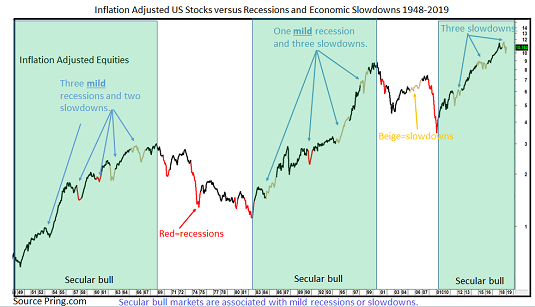
View Larger Chart Online
Image Source: Pring.com
As you can see, the stock market never fares well during/around recessions. However, slowdowns are another story.
As the chart illustrates, the bulls didn't pay much attention to the three mild slowdowns that occurred during the 1982-1999 secular bull market. Basically, stocks paused for a bit when things slowed down and then continued to power forward.
But since then, the story is a little different as stocks have struggled at the beginning of each slowdown. So, the question in my mind is whether this slowdown is just getting started or closer to an end?
Two Ways To Play
If it's the former, then a "retest" scenario is the likely outcome and a tactical, trend-following approach could come in quite handy. Remember, waterfall decline lows tend to be "tested" within a couple months of the low as the original reason for the decline usually resurfaces. So, will the bears return if the #GrowthSlowing issue isn't "fixed" by a trade deal tout suite?
On the other hand, if the current data winds up being merely confirmation of the slowdown everybody already knows about and a trade deal can reinvigorate global growth, then a move to new highs is a logical outcome. And as far as the appropriate strategy for the market driver is concerned, in a rebounding growth environment, a buy-the-dips strategy is usually a good way to play.
Another Driver to Consider
Yet, I believe there is an additional driver of market action to consider here. It's called "positioning."
According to JP Morgan's Marko Kolanovic, hedge funds and other systematic trading strategies were caught flat footed by the recent surge in the stock market and are in the process of playing catch up on a daily basis.
In an interview on CNBC last week, Kolanovic stated that the "beta positioning" of hedge funds and systematic investors is currently "in the 20th to 30th percentile." Kolanovic noted that while the current reading is well above the December level of "close to zero," it is still below normal.
In other words, there is an entire segment of market participants that has been and remains underinvested. From my seat, this helps explain why there have been no pullbacks to speak of for the last nine weeks and why intraday dips are being bought on a consistent basis.
Kolanovic suggests that it is for this reason that the current rally can continue. The guy who has made some impressive market calls over the past couple years, says that the current pace obviously can't be sustained. But as long as a trade deal gets done, Kolanovic feels money flows will continue to sustain the market.
Summing Up...
In summary, it looks like the current rally has "corrected" the correction that was based on fears of policy mistakes by both the Fed and the administration. Now the bullish assumption seems to be that a trade deal will "fix" the #GrowthSlowing issue. And with money continuing to flow into stocks from underinvested traders, it seems the rally can just keep on keepin' on.
My take is the risks here are obvious. First, there is the risk that a trade deal doesn't get done in a timely fashion. And second, that growth, which was slowing long before the trade spat with China began, continues to falter as the global synchronized slowdown continues.
Weekly Market Model Review
Now let's turn to the weekly review of my favorite indicators and market models...
The State of the Big-Picture Market Models
I like to start each week with a review of the state of my favorite big-picture market models, which are designed to help me determine which team is in control of the primary trend.
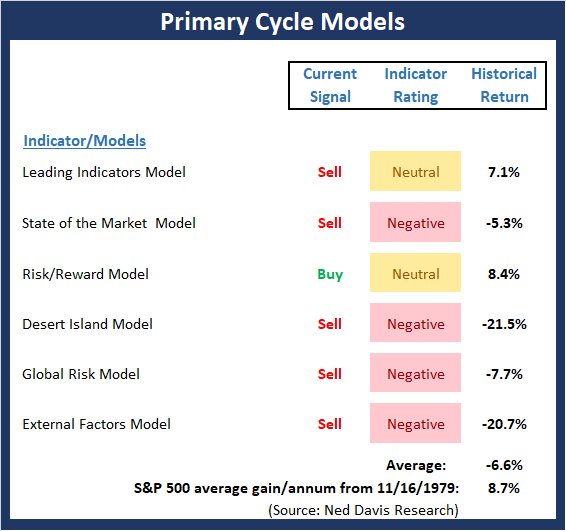
View My Favorite Market Models Online
The Bottom Line:
- While the bull case seems strong here, my "Primary Cycle" board continues to give me pause. If just one or two of my favorite longer-term "state of the market" models was negative, I think I could give it a pass. However, with five out of six on sell signals and four sporting negative readings, I'm concerned about the health of the market. At the very least, this board suggests that some caution is warranted in the near-term.
This week's mean percentage score of my 6 favorite models slipped to 40.3% from 44.2% last week (2 weeks ago: 48.9%, 3 weeks ago: 48.9%, 4 weeks ago: 47.8%) while the median improved to 42.5% from 40% last week (2 weeks ago: 46.7%, 3 weeks ago: 46.7%, 4 weeks ago: 45%).
The State of the Trend
Once I've reviewed the big picture, I then turn to the "state of the trend." These indicators are designed to give us a feel for the overall health of the current short- and intermediate-term trend models.
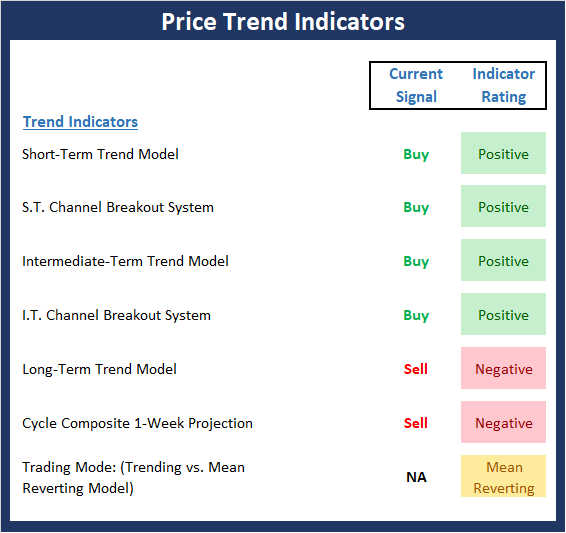
View Trend Indicator Board Online
The Bottom Line:
- With the market having retraced all of the December dive, it is easy to view the trend as being positive. And with the majority of Trend board positive, the indicators agree.
The State of Internal Momentum
Next up are the momentum indicators, which are designed to tell us whether there is any "oomph" behind the current trend.
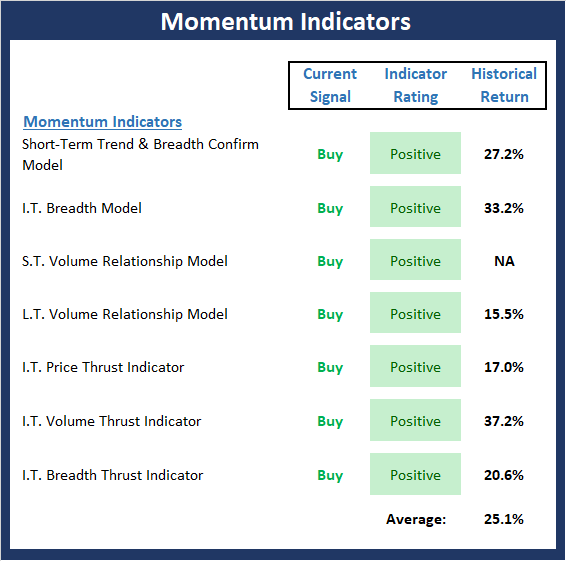
View Momentum Indicator Board Online
The Bottom Line:
- The Momentum board remains completely green again this week. And with every indicator currently sporting a positive rating, the advantage stays with the bulls and suggests that a buy-the-dip strategy is the way to play.
The State of the "Trade"
We also focus each week on the "early warning" board, which is designed to indicate when traders might start to "go the other way" -- for a trade.
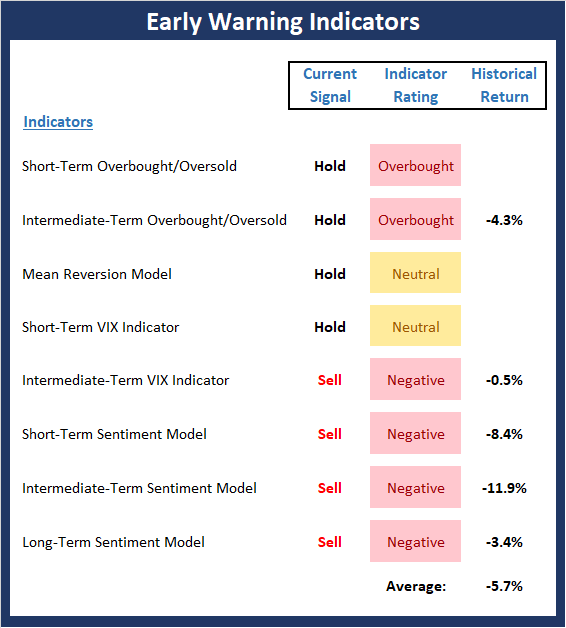
View Early Warning Indicator Board Online
The Bottom Line:
- The Early Warning board continues to warrant attention. It should be noted that the 40-period RSI is currently at one of the highest readings in history and that our Long-Term Sentiment Model flashed a sell signal last week. In short, the board suggests that the table is now set for a counter-trend move.
The State of the Macro Picture
Now let's move on to the market's fundamental factors - the indicators designed to tell us the state of the big-picture market drivers including monetary conditions, the economy, inflation, and valuations.

View Fundamental Indicator Board Online
The Bottom Line:
- Sorry to sound like a broken record, but the Fundamental Factors board suggests the backdrop for equities remains constructive. My take is the board tells me the bulls should be given the benefit of any doubt from near-term perspective.
Thought For The Day:
Some men see things as they are and ask why. I dream things that never were and ask why not? -Robert F. Kennedy/George Bernard Shaw
Wishing you green screens and all the best for a great day,

David D. Moenning
Founder, Chief Investment Officer
Heritage Capital Research
HCR Focuses on a Risk-Managed Approach to Investing
What Risk Management Can and Cannot Do
HCR Awarded Top Honors in 2018 NAAIM Shark Tank Portfolio Strategy Competition
Each year, NAAIM (National Association of Active Investment Managers) hosts a competition to identify the best actively managed investment strategies. In April, HCR's Dave Moenning took home first place for his flagship risk management strategy.
Disclosures
At the time of publication, Mr. Moenning held long positions in the following securities mentioned: None - Note that positions may change at any time.
Leading Indicators Model: A group of indicators that have historically shown tendencies to lead the market at major turning points.
The State of the Market Model: Designed to provide a composite reading for the technical health of the broad equity market. A diffusion indicator based on the status of more than 100 component indicators.
Risk/Reward Model: A model-of-models intended to provide an overall view of the state of the risk/reward environment. The model includes tape, monetary, and sentiment indicators as well as 7 big-picture market model readings.
Desert Island Model: If I was stranded on a desert island with access to only one market model to manage money with, this would be the model. The model is a comprehensive model-of-models comprised of trend, momentum, mean reversion, economic, monetary, sentiment, and factor-based indicators/models.
External Factors Model: A model-of-models designed to provide a reading on the "macro state" of the market environment. The model is comprised of indicators/models in the areas of various index yields, industrial production, investors sentiment, and historic volatility.
Short-Term Trend-and-Breadth Signal Explained: History shows the most reliable market moves tend to occur when the breadth indices are in gear with the major market averages. When the breadth measures diverge, investors should take note that a trend reversal may be at hand. This indicator incorporates NDR's All-Cap Dollar Weighted Equity Series and A/D Line. From 1998, when the A/D line is above its 5-day smoothing and the All-Cap Equal Weighted Equity Series is above its 25-day smoothing, the equity index has gained at a rate of +32.5% per year. When one of the indicators is above its smoothing, the equity index has gained at a rate of +13.3% per year. And when both are below, the equity index has lost +23.6% per year.
Channel Breakout System Explained: The short-term and intermediate-term Channel Breakout Systems are modified versions of the Donchian Channel indicator. According to Wikipedia, "The Donchian channel is an indicator used in market trading developed by Richard Donchian. It is formed by taking the highest high and the lowest low of the last n periods. The area between the high and the low is the channel for the period chosen."
Intermediate-Term Trend-and-Breadth Signal Explained: This indicator incorporates NDR's All-Cap Dollar Weighted Equity Series and A/D Line. From 1998, when the A/D line is above its 45-day smoothing and the All-Cap Equal Weighted Equity Series is above its 45-day smoothing, the equity index has gained at a rate of +17.6% per year. When one of the indicators is above its smoothing, the equity index has gained at a rate of +6.5% per year. And when both are below, the equity index has lost -1.3% per year.
Cycle Composite Projections: The cycle composite combines the 1-year Seasonal, 4-year Presidential, and 10-year Decennial cycles. The indicator reading shown uses the cycle projection for the upcoming week.
Trading Mode Indicator: This indicator attempts to identify whether the current trading environment is "trending" or "mean reverting." The indicator takes the composite reading of the Efficiency Ratio, the Average Correlation Coefficient, and Trend Strength models.
Volume Relationship Models: These models review the relationship between "supply" and "demand" volume over the short- and intermediate-term time frames.
Price Thrust Model Explained: This indicator measures the 3-day rate of change of the Value Line Composite relative to the standard deviation of the 30-day average. When the Value Line's 3-day rate of change have moved above 0.5 standard deviation of the 30-day average ROC, a "thrust" occurs and since 2000, the Value Line Composite has gained ground at a rate of +20.6% per year. When the indicator is below 0.5 standard deviation of the 30-day, the Value Line has lost ground at a rate of -10.0% per year. And when neutral, the Value Line has gained at a rate of +5.9% per year.
Volume Thrust Model Explained: This indicator uses NASDAQ volume data to indicate bullish and bearish conditions for the NASDAQ Composite Index. The indicator plots the ratio of the 10-day total of NASDAQ daily advancing volume (i.e., the total volume traded in stocks which rose in price each day) to the 10-day total of daily declining volume (volume traded in stocks which fell each day). This ratio indicates when advancing stocks are attracting the majority of the volume (readings above 1.0) and when declining stocks are seeing the heaviest trading (readings below 1.0). This indicator thus supports the case that a rising market supported by heavier volume in the advancing issues tends to be the most bullish condition, while a declining market with downside volume dominating confirms bearish conditions. When in a positive mode, the NASDAQ Composite has gained at a rate of +38.3% per year, When neutral, the NASDAQ has gained at a rate of +13.3% per year. And when negative, the NASDAQ has lost at a rate of -12.229% per year.
Breadth Thrust Model Explained: This indicator uses the number of NASDAQ-listed stocks advancing and declining to indicate bullish or bearish breadth conditions for the NASDAQ Composite. The indicator plots the ratio of the 10-day total of the number of stocks rising on the NASDAQ each day to the 10-day total of the number of stocks declining each day. Using 10-day totals smooths the random daily fluctuations and gives indications on an intermediate-term basis. As expected, the NASDAQ Composite performs much better when the 10-day A/D ratio is high (strong breadth) and worse when the indicator is in its lower mode (weak breadth). The most bullish conditions for the NASDAQ when the 10-day A/D indicator is not only high, but has recently posted an extreme high reading and thus indicated a thrust of upside momentum. Bearish conditions are confirmed when the indicator is low and has recently signaled a downside breadth thrust. In positive mode, the NASDAQ has gained at a rate of +22.1% per year since 1981. In a neutral mode, the NASDAQ has gained at a rate of +14.5% per year. And when in a negative mode, the NASDAQ has lost at a rate of -6.4% per year.
Short-Term Overbought/sold Indicator: This indicator is the current reading of the 14,1,3 stochastic oscillator. When the oscillator is above 80 and the %K is above the %D, the indicator gives an overbought reading. Conversely, when the oscillator is below 20 and %K is below its %D, the indicator is oversold.
Intermediate-Term Overbought/sold Indicator: This indicator is a 40-day RSI reading. When above 57.5, the indicator is considered overbought and wnen below 45 it is oversold.
Mean Reversion Model: This is a diffusion model consisting of five indicators that can produce buy and sell signals based on overbought/sold conditions.
VIX Indicator: This indicators looks at the current reading of the VIX relative to standard deviation bands. When the indicator reaches an extreme reading in either direction, it is an indication that a market trend could reverse in the near-term.
Short-Term Sentiment Indicator: This is a model-of-models composed of 18 independent sentiment indicators designed to indicate when market sentiment has reached an extreme from a short-term perspective. Historical analysis indicates that the stock market's best gains come after an environment has become extremely negative from a sentiment standpoint. Conversely, when sentiment becomes extremely positive, market returns have been subpar.
Intermediate-Term Sentiment Indicator: This is a model-of-models composed of 7 independent sentiment indicators designed to indicate when market sentiment has reached an extreme from a intrmediate-term perspective. Historical analysis indicates that the stock market's best gains come after an environment has become extremely negative from a sentiment standpoint. Conversely, when sentiment becomes extremely positive, market returns have been subpar.
Long-Term Sentiment Indicator: This is a model-of-models composed of 6 independent sentiment indicators designed to indicate when market sentiment has reached an extreme from a long-term perspective. Historical analysis indicates that the stock market's best gains come after an environment has become extremely negative from a sentiment standpoint. Conversely, when sentiment becomes extremely positive, market returns have been subpar.
Absolute Monetary Model Explained: The popular cliche, "Don't fight the Fed" is really a testament to the profound impact that interest rates and Fed policy have on the market. It is a proven fact that monetary conditions are one of the most powerful influences on the direction of stock prices. The Absolute Monetary Model looks at the current level of interest rates relative to historical levels and Fed policy.
Relative Monetary Model Explained: The "relative" monetary model looks at monetary indicators relative to recent levels as well as rates of change and Fed Policy.
Economic Model Explained: During the middle of bull and bear markets, understanding the overall health of the economy and how it impacts the stock market is one of the few truly logical aspects of the stock market. When our Economic model sports a "positive" reading, history (beginning in 1965) shows that stocks enjoy returns in excess of 21% per year. Yet, when the model's reading falls into the "negative" zone, the S&P has lost nearly -25% per year. However, it is vital to understand that there are times when good economic news is actually bad for stocks and vice versa. Thus, the Economic model can help investors stay in tune with where we are in the overall economic cycle.
Inflation Model Explained: They say that "the tape tells all." However, one of the best "big picture" indicators of what the market is expected to do next is inflation. Simply put, since 1962, when the model indicates that inflationary pressures are strong, stocks have lost ground. Yet, when inflationary pressures are low, the S&P 500 has gained ground at a rate in excess of 13%. The bottom line is inflation is one of the primary drivers of stock market returns.
Valuation Model Explained: If you want to get analysts really riled up, you need only to begin a discussion of market valuation. While the question of whether stocks are overvalued or undervalued appears to be a simple one, the subject is actually extremely complex. To simplify the subject dramatically, investors must first determine if they should focus on relative valuation (which include the current level of interest rates) or absolute valuation measures (the more traditional readings of Price/Earnings, Price/Dividend, and Price/Book Value). We believe that it is important to recognize that environments change. And as such, the market's focus and corresponding view of valuations are likely to change as well. Thus, we depend on our Valuation Models to help us keep our eye on the ball.
Disclosures
The opinions and forecasts expressed herein are those of Mr. David Moenning and may not actually come to pass. Mr. Moenning's opinions and viewpoints regarding the future of the markets should not be construed as recommendations. The analysis and information in this report is for informational purposes only. No part of the material presented in this report is intended as an investment recommendation or investment advice. Neither the information nor any opinion expressed constitutes a solicitation to purchase or sell securities or any investment program.
Any investment decisions must in all cases be made by the reader or by his or her investment adviser. Do NOT ever purchase any security without doing sufficient research. There is no guarantee that the investment objectives outlined will actually come to pass. All opinions expressed herein are subject to change without notice. Neither the editor, employees, nor any of their affiliates shall have any liability for any loss sustained by anyone who has relied on the information provided.
Mr. Moenning may at times have positions in the securities referred to and may make purchases or sales of these securities while publications are in circulation. Positions may change at any time.
The analysis provided is based on both technical and fundamental research and is provided "as is" without warranty of any kind, either expressed or implied. Although the information contained is derived from sources which are believed to be reliable, they cannot be guaranteed.
Investments in equities carry an inherent element of risk including the potential for significant loss of principal. Past performance is not an indication of future results.

